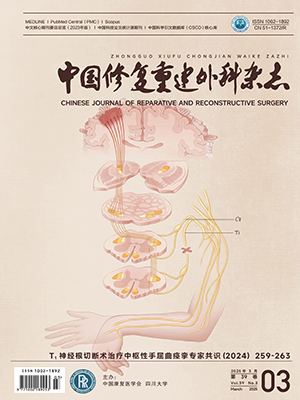Objective To investigate the key parameters of three-dimensional anatomy of the proximal humerus and compare the differences between male and female, and between left and right sides in Chinese by volume rendering technique with multi-slice spiral CT (MSCT) so as to provide a reference for a new prosthesis of the proximal humerus which can adjust to the anatomical characteristics of Chinese. Methods A total of 100 healthy volunteers were collected from Chongqing of China, including 59 males and 41 females with an average age of 40.4 years (range, 21-57 years). The humeral retroversion angle (RA), neck-shaft angle (NSA), medial offset (MO), and posterior offset (PO) were measured by volume rendering technique with MSCT. The average values were compared between male and female and between left and right sides, the correlation of these parameters was also analysed. Results In 100 volunteers (200 sides), the RA was (19.9 ± 10.6)°, the NSA was (134.7 ± 3.8)°, the MO was (4.0 ± 1.1) mm, and the PO was (2.6 ± 1.3) mm. There were significant differences in RA and MO between left and right sides (P lt; 0.05); there was no significant difference in NSA and PO between left and right sides (P gt; 0.05). The PO and RA of both sides in male were significantly larger than those in female (P lt; 0.05); the NSA and MO in male were similar to those in female (P gt;0.05). PO was correlated positively with RA (r=0.617, P=0.000); MO was not correlated with NSA (r= —0.124, P=0.081). Conclusion Because of significant side differences in RA and MO, and significant gender differences in RA and PO, the differences should be considered in the design of new proximal humeral prosthesis and proximal humerus reconstruction.
Citation: GONG Jicheng,TANG Kanglai,CAO Honghui,LI Jinqing,CHEN Wei,WANG Huaqing,CHEN Lei. MEASUREMENT AND ANALYSIS OF THREE-DIMENSIONAL ANATOMY OF PROXIMAL HUMERUS. Chinese Journal of Reparative and Reconstructive Surgery, 2011, 25(9): 1074-1077. doi: Copy
Copyright © the editorial department of Chinese Journal of Reparative and Reconstructive Surgery of West China Medical Publisher. All rights reserved




